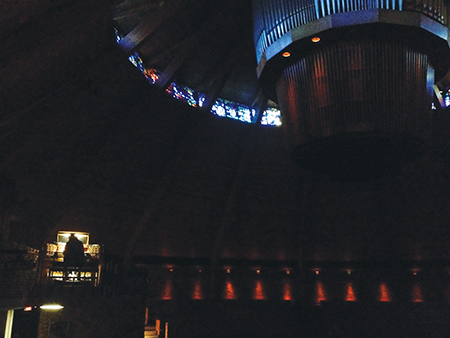Live: Charlemagne Palestine
Yale Union, Portland, Oregon, USA
Yale Union, Portland, Oregon, USA

Charlemagne Palestine’s long career, which stretches back to the 1960s, is anchored by an earnest devotion to his motifs: musical drone, chants, Cognac, scarves, ceremony and heaps of stuffed animals. After decades of what he has called ‘exile’ in Europe from his native United States, Palestine has recently been sharing his cosmology with audiences worldwide. For the uninitiated, it can be baffling: how to grasp a practice that appears so fully formed in its eccentricity, with little sense of how it arrived?
Perhaps it was with this issue in mind that Palestine’s appearance at Yale Union comprised a three-night series, expressing his concerns through various means – piano, voice, video, installation, pipe organ and showmanship. Although based in sound, Palestine’s performances are intensely visual, integrating a plethora of objects. The Bösendorfer piano that he played on the first night was decked in stuffed animals, fabric strips and candles. It was tucked at the back of Yale Union’s long space, the remainder of which was filled with yet more piles of soft toys under rainbow spotlights – grouped in what Palestine called ‘tribes’ – at each grand window, or suspended by parachutes from the ceiling. In conversation, Palestine refutes the idea that such gestures are ‘mere set pieces’, insisting that the animals are more like muses, co-conspirators in each performance.
It was in this company that Palestine held his first two performances. The first evening centered around the piano, but began with Cognac: following a sip, Palestine ran his finger along the glass’s rim, teasing out a tone. He then took to the piano to summon deeper resonances. For nearly an hour, Palestine demonstrated his ‘strumming’ technique, hammering away at two notes in alternation with the sustain pedal pressed throughout. Accompanied by gravelly vocalizations, the simplicity of Palestine’s strumming fanned out into a spectrum of overtones, ultimately bottoming out in a bleak rumble. Once it subsided, Palestine returned to the Cognac (this time clinking two glasses between sips, augmenting pitch), and concluded with twin Singamajigs – creatures who sing a note each time they’re squeezed. He held them before his face, squeezing insistently until their song ended and they giggled ‘goodbye’.
If, on the first night, Palestine extracted resonances from objects, the second night’s video screening depicted a younger Palestine’s attempts to extract force from his own body. In the earliest works, the artist subjects his burly frame to dramatic endurance challenges – sprinting laps around rooms while chanting, running into walls or gesticulating before animal altars. Like the piano, Palestine’s body is repeatedly sapped for maximum impact, expelling energy to the point of collapse. The screening concluded with the nightmarish self-portraiture of Dark Into Dark (1979). In it, Palestine seems to channel the dialogue of inner demons: he cackles, pleads and screams at the camera in different registers, shatters glasses against walls and weeps. During the following Q&A session with the audience, Palestine distanced himself from ‘the troubled young man on the screen’, but his appearance was instructive: it provided psychic traction, rooting the artist’s present-day routine, with all its exuberance, in the struggles and intensities that preceded it.
On the final night, Palestine returned again to live music, this time playing the pipe organ at Lewis & Clark College’s Agnes Flanagan Chapel. In his opening remarks, Palestine explained how the organ is, for him, the real deal. Whereas the piano requires amplification in a large space – and thus mediation – organs move ‘real air in real space’. They are also often inseparable from their architecture. Here, the chapel was circular, with 5,000 pipes (‘each one an instrument’) hanging from the centre of the ceiling with the audience spread out beneath it. Palestine had not rehearsed on the organ, and he was content to announce that fact – each performance is a real-time investigation of the apparatus, more a summoning than a recitation.
Perched above the pews in the circular chapel, Palestine began playing with a high hum and gradually built, adding deeper registers that announced themselves in pulses before integrating into the whole. With the artist out of view and only a modest clump of animals on the stage, his visual presence was surprisingly sparse – the focus was resolutely on sound. As Palestine’s sonic accumulation approached its deafening peak, audience members tested their physical involvement in it: less subjects than receivers, they took to rotating their heads, pulling their ears forward or orbiting the room, pressing through air thick with tone. Eventually, the sound ceased and Palestine, Cognac in hand, returned to the front to announce: ‘The pipe organ is the greatest instrument in the world.’ That night, his instrument encompassed not just pipes and space, but the people who populated it. Palestine played bodies.
























